This lesson develops area functions using a visual approach by exploring the values of the areas under a curve when the right-hand endpoint changes. The concept is illustrated by graphing a definite integral in which the right-hand endpoint is variable.
If a non-negative curve and a left-hand endpoint are given, an area function can be found for a right-hand endpoint that varies. It is necessary to distinguish between the independent variables for the curve function and for the area function. If x is used to denote the variable right-hand endpoint of the region, a second variable, t, could be used in the description of the curve function.
Letting x represent the right-hand endpoint, the area under the curve ![]() and above the t-axis between t = 1 and t = x can be found by evaluating the definite integral
and above the t-axis between t = 1 and t = x can be found by evaluating the definite integral ![]() .
.
For example, if x = 3 the area under the curve between t = 1 and t = 3 is about 1.099, as illustrated in the screens below.

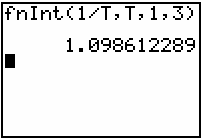
18.2.1 Use the Definite Integral command to find the areas under
![]() between 1 and the following values of x. Record your results in the table, rounding your answers to three decimal places.
between 1 and the following values of x. Record your results in the table, rounding your answers to three decimal places.

Click here for the answer.
18.2.2 Make a scatter plot of your results and find the logarithmic regression (LnReg) equation that best fits the data. Graph this equation together with the scatter plot.
Click here for the answer.
Based on how closely the function fits the data, it appears that the area function may be the natural logarithmic function A (x) = ln x.
Graphing Integrals
The procedure below will graph
![]() together with the scatter plot.
together with the scatter plot.
- Disable or delete the regression equation in the Y= editor.
- Set Y1 = fnInt(1/T,T,1,X) and use the window [0.01, 5,1] x [-1 2,1].
- Graph the equation Y1.
The graph will be slow to appear because the calculator has to compute a new definite integral for each point it plots, but you should see the area function
![]() develop point by point.
develop point by point.

Notice that the graph of A(x) appears to be the same as the graph of y = lnx, the regression equation we found above.
18.2.3 Based on these graphs, predict the function that is equal to
![]() .
.
Click here for the answer.
18.2.4 Describe how the Fundamental Theorem of Calculus applies.
Click here for the answer.
Illustrating ![]()
Suppose that you do not know a formula for the curve function but you have its graph. You can determine the shape of the area function by analyzing the graph of the curve.
Below is the graph of ![]() shown in a [0, 5, 1] x [-1, 3, 1] window.
shown in a [0, 5, 1] x [-1, 3, 1] window.
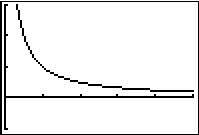
Visualize the area under the graph of f being filled with thin rectangular sticks where the height of each stick is the y-value of the curve function. Each successive rectangular stick is shorter than the prior one. The Riemann sum is growing more slowly with each step as you move to the right because the area of each successive rectangle is less than the one before, as shown below.
Therefore the area function is increasing at a decreasing rate. This means the area function is concave downward.
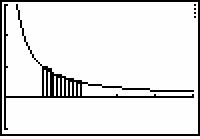 |
 |
|
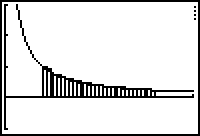 |
||
Using the Fundamental Theorem of Calculus
The Fundamental Theorem of Calculus states that the derivative of the area function is the curve function. That means that the curve function values correspond to slopes of tangent lines of the area function.
Some of the characteristics of the area function that can be determined from the graph of the curve function are listed below.
- A curve function's y-value at x is the slope of the tangent line of the area function at that x-value.
- When the curve function is decreasing, the area function's slopes are decreasing and its graph is concave downward.
- When the curve function is increasing, the area function's slopes are increasing and its graph is concave upward.
18.2.5 Examine the graph of f(x) between x = 0 and x = 4 shown below. Consider how the area function ![]() grows as x increases. Approximate the graph of the corresponding area function on the interval from 0 to 4.
grows as x increases. Approximate the graph of the corresponding area function on the interval from 0 to 4.
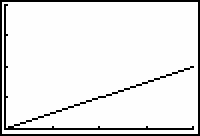
Click here for the answer.